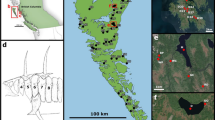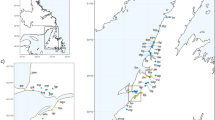Abstract
The repeated colonization of freshwater habitats by the ancestrally marine threespined stickleback Gasterosteus aculeatus has been associated with many instances of parallel reduction in armour traits, most notably number of lateral plates. The change in predation regime from marine systems, dominated by gape-limited predators such as piscivorous fishes, to freshwater habitats where grappling invertebrate predators such as insect larvae can dominate the predation regime, has been hypothesized as a driving force. Here we experimentally test the hypothesis that stickleback with reduced armour possess a selective advantage in the face of predation by invertebrates, using a natural population of stickleback that is highly polymorphic for armour traits and a common invertebrate predator from the same location. Our results provide no compelling evidence for selection in this particular predator–prey interaction. We suggest that the postulated selective advantage of low armour in the face of invertebrate predation may not be universal.




Similar content being viewed by others
References
Bańbura J (1994) Lateral plate morph differentiation of freshwater and marine populations of the three-spined stickleback, Gasterosteus aculeatus, in Poland. J Fish Biol 44:773–783
Barrett RDH (2010) Adaptive evolution of lateral plates in three-spined stickleback Gasterosteus aculeatus: a case study in functional analysis of natural variation. J Fish Biol 77:311–328
Barrett R, Rogers S, Schluter D (2008) Natural selection on a major armor gene in threespine stickleback. Science 322:255–257
Bell MA, Foster SA (eds) (1994) The evolutionary biology of the threespine stickleback. Oxford University Press, New York
Bell MA, Orti G, Walker JA, Koenigs JP (1993) Evolution of pelvic reduction in threespine stickleback fish—a test of competing hypothesis. Evolution 47:906–914
Bergstrom CA (2002) Fast-start swimming performance and reduction in lateral plate number in threespine stickleback. Can J Zool 80:207–213
Berner D, Roesti M, Hendry AP, Salzburger W (2010) Constraints on speciation suggested by comparing lake-stream stickleback divergence across two continents. Mol Ecol 19:4963–4978
Bjærke O, Østbye K, Lampe HM, Vøllestad LA (2010) Covariation in shape and foraging behaviour in lateral plate morphs in the three-spined stickleback. Ecol Freshw Fish 19:249–256
Colosimo PF, Peichel CL, Nereng K, Blackman BK, Shapiro MD, Schluter D, Kingsley DM (2004) The genetic architecture of parallel armor plate reduction in threespine sticklebacks. PLoS Biol 2:e109
Colosimo PF, Hosemann KE, Balabhadra S, Villarreal G, Dickson M, Grimwood J, Schmutz J, Myers RM, Schluter D, Kingsley DM (2005) Widespread parallel evolution in sticklebacks by repeated fixation of Ectodysplasin alleles. Science 307:1928–1933
Conner J (2001) How strong is natural selection? Trends Ecol Evol 16:215–217
Cresko W, Amores A, Wilson C, Murphy J, Currey M, Phillips P, Bell M, Kimmel C, Postlethwait J (2004) Parallel genetic basis for repeated evolution of armor loss in Alaskan threespine stickleback populations. Proc Natl Acad Sci USA 101:6050–6055
Curry RA, Currie SL, Arndt SK, Bielak AT (2005) Winter survival of age-0 smallmouth bass, Micropterus dolomieu in north eastern lakes. Environ Biol Fishes 72:111–122
Endler JA (1986) Natural selection in the wild. Princeton University Press, Princeton
Ernande B, Dieckmann U, Heino M (2004) Adaptive changes in harvested populations: plasticity and evolution of age and size at maturation. Proc R Soc Lond B Biol Sci 271:415
Foster SA, Garcia VB, Town MY (1988) Cannibalism as the cause of an ontogenetic shift in habitat use by fry of the threespine stickleback. Oecologia 74:577–585
Gårdmark A, Dieckmann U (2006) Disparate maturation adaptations to size-dependent mortality. Proc R Soc Lond B Biol Sci 273:2185
Giles N (1983) The possible role of environmental calcum levels during the evolution of phenotypic diversity in Outer Hebridean populations of the Three-spined stickleback, Gasterosteus aculeatus. J Zool (Lond) 199:535–544
Gross HP (1978) Natural selection by predators on the defensive apparatus of the three-spined stickleback, Gasterosteus aculeatus L. Can J Zool 56:398–413
Helfman GS, Collette BB, Facey DE (1997) The Diversity of Fishes. Blackwell Science, Inc, Hoboken, pp 141–145
Hendry AP, Hudson K, Walker JA, Räsänen K, Chapman LJ (2010) Genetic divergence in morphology-performance mapping between Misty Lake and inlet stickleback. J Evol Biol 24:23–35
Heuts MJ (1947) The phenotypical variability of Gasterosteus aculeatus L. populations in Belgium. Mededel Koninkl Vlaam Akad Wetenschap 9:5–63
Hoogland R, Morris D, Tinbergen N (1956) The spines of sticklebacks (Gasterosteus and Pygosteus) as means of defence against predators (Perca and Esox). Behaviour 10:205–236
Johnson J (2001) Adaptive life-history evolution in the livebearing fish Brachyrhaphis rhabdophora: genetic basis for parallel divergence in age and size at maturity and a test of predator-induced plasticity. Evolution 55:1486–1491
Lahti DC, Johnson NA, Ajie BC, Otto SP, Hendry AP, Blumstein DT, Coss RG, Donohue K, Foster SA (2009) Relaxed selection in the wild. Trends Ecol Evol 24:487–496
Langerhans RB, Gifford ME, Joseph EO (2007) Ecological speciation in Gambusia fishes. Evolution 61:2056–2074
Lucek K, Roy D, Bezault E, Sivasundar A, Seehausen O (2010) Hybridization between distant lineages increases adaptive variation during a biological invasion: stickleback in Switzerland. Mol Ecol 19:3995–4011
Marchinko KB (2009) Predation’s role in repeated phenotypic and genetic divergence of armor in threespine stickleback. Evolution 63:127–138
Marchinko K, Schluter D (2007) Parallel evolution by correlated response: lateral plate reduction in threespine stickleback. Evolution 61:1084–1090
McKinnon JS, Rundle HD (2002) Speciation in nature: the threespine stickleback model systems. Trends Ecol Evol 17:480–488
Munzing J (1959) Biologie, Variabilitat, und genetik von Gasterosteus aculeatus L. (Pisces). Untersuchungen im Elbegebiet. Int Revue Gesamten Hydrobiol 44:317–382
Myhre F, Klepaker T (2009) Body armour and lateral-plate reduction in freshwater three-spined stickleback Gasterosteus aculeatus: adaptations to a different buoyancy regime? J Fish Biol 75:2062–2074
Peichel CL, Nereng KS, Ohgi KA, Cole BL, Colosimo PF, Buerkle CA, Schluter D, Kingsley DM (2001) The genetic architecture of divergence between threespine stickleback species. Nature 414:901–905
Peichel CL, Ross JA, Matson CK, Dickson M, Grimwood J, Schmutz J, Myers RM, Mori S, Schluter D, Kingsley DM (2004) The master sex-determination locus in threespine sticklebacks is on a nascent Y chromosome. Curr Biol 14:1416–1424
Reimchen TE (1980) Spine deficiency and polymorphism in a population of Gasterosteus aculeatus—an adaptation to predators? Can J Zool 58:1232–1244
Reimchen TE (1992a) Extended longevity in a large-bodied stickleback, Gasterosteus, population. Can Field-Nat 106:122–125
Reimchen TE (1992b) Injuries on stickleback from attacks by a toothed predator (Oncorhynchus) and implications for the evolution of lateral plates. Evolution 46:1224–1230
Reimchen TE (1994) Predators and morphological evolution in threespine stickleback.The Evolutionary Biology of the Threespine Stickleback. M. A. Bell and S. A. Foster, Oxford University Press, New York, pp 240–276
Reimchen TE (2000) Predator handling failures of lateral plate morphs in Gasterosteus aculeatus: functional implications for the ancestral plate condition. Behaviour 137:1081–1096
Reznick D, Endler J (1982) The impact of predation on life history evolution in Trinidadian guppies (Poecilia reticulata). Evolution 36:160–177
Rundle HD, Nosil P (2005) Ecological speciation. Ecol Lett 8:336–352
Schluter D (2000) The ecology of adaptive radiation. Oxford University Press, New York
Schluter D, Conte GL (2009) Genetics and ecological speciation. Proc Natl Acad Sci USA 106:9955
Ungerer MC, Linder CR, Rieseberg LH (2003) Effects of genetic background on response to selection in experimental populations of Arabidopsis thaliana. Genetics 163:277–286
Vamosi S (2002) Predation sharpens the adaptive peaks: survival trade-offs in sympatric sticklebacks. Ann Zool Fenn 39:237–248
Vamosi S (2005) On the role of enemies in divergence and diversification of prey: a review and synthesis. Can J Zool 83:894–910
Walsh M, Reznick D (2009) Phenotypic diversification across an environmental gradient: a role for predators and resource availability on the evolution of life histories. Evolution 63:3201–3213
Acknowledgments
The experiments reported in this study were approved by the veterinary office of the Canton of Bern and complied with all legal requirements in Switzerland (permit no. BE51/09). We thank the members of the Eawag Fish Ecology and Evolution lab for constructive feedback and two anonymous reviewers of previous versions of the manuscript for their comments.
Author information
Authors and Affiliations
Corresponding author
Electronic supplementary material
Below is the link to the electronic supplementary material.
Rights and permissions
About this article
Cite this article
Zeller, M., Lucek, K., Haesler, M. et al. Little evidence for a selective advantage of armour-reduced threespined stickleback individuals in an invertebrate predation experiment. Evol Ecol 26, 1293–1309 (2012). https://doi.org/10.1007/s10682-012-9566-2
Received:
Accepted:
Published:
Issue Date:
DOI: https://doi.org/10.1007/s10682-012-9566-2




